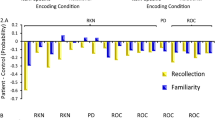Summary
A large number of psycholinguistic findings on how human beings store lexical information suggest the existence of associative memory, which may be characterized by a large capacity and a long duration. Its anatomical basis supposedly is, at least in part, the frontal lobes, and some of its functional characteristics have been tentatively linked to dopamine release. Working memory has a limited capacity, lasts only for seconds and is relevant for goal-directed behavior. Its anatomical basis in the frontal cortex is established and strong evidence suggests the involvement of dopaminergic pathways. Experimental evidence using several lexical decision tasks and a delayed response task is provided to demonstrate that some characteristic features of schizophrenic thinking — in particular the rapid shift of associations, the indirect relationship of associations, the overly abstract or overly concrete use of concepts, the lack of context-sensitivity and of general integrative function and intellectual capacity — can be explained in terms of an activation or disinhibition of associative memory, and of a dysfunctional working memory. The findings serve as an example of schizophrenia reserarch in a cognitive neuroscience framework.
Similar content being viewed by others
References
American Psychiatric Association (1987) Diagnostic and Statistical Manual of Mental Disorders, 3rd edition, revised (DSM-III-R). American Psychiatric Association, Washington DC
Balota DA, Lorch RF (1986) Depth of automatic spreading activation: mediated priming effects in pronunciation but not in lexical decision. J Exp Psychol Learn Mem Cognition 12, 336–345
Beringer K (1926) Beitrag zur Analyse schizophrener Denkstörungen. Z Neurol Psychiatr 93:55–61
Beringer K (1926) Denkstörungen und Sprache bei Schizophrenen. Z Neurol Psychiatr 103:185–197
Bleuler E (1911) Dementia Praecox oder die Gruppe der Schizophrenien. Deuticke, Leipzig
Braff DL, Heaton R, Kuck J, Cullum M, Moranville J, Grant I, Zisook S (1991): The generalized pattern of neuropsychological deficits in outpatients with chronic schizophrenia with heterogeneous Wisconsin card sorting test results. Arch Gen Psychiatry 48:891–898
Callway E (1992) Psychopharmacology's need for linking variables. Biol Psychiatry 31:1–3
Cameron N (1939) Deterioration and regression in schizophrenic thinking. J Abnorm Soc Psychol 34:265
Carlsson A (1988) The current status of the dopamine hypothesis of schizophrenia. Neuropsychopharmacology 1:179–203
Chaika EO (1974) A linguist looks at “schizophrenic” language. Brain Lang 1:257–276
Chaika EO (1990) Understanding psychotic speech. Charles C. Thomas, Springfield, Illinois
Chapin K, Vann LE, Lycaki H, Josef N, Mcyendorff E (1989) Investigation of the associative network in schizophrenia using the semantic priming paradigm. Schizophrenia Res 2:355–360
Chapman LJ (1960) Confusion of figurative and literal usage of words by schizophrenics and brain damaged patients. J Abnormal Soc Psychol 60:412–416
Chapman LJ, Chapman JP, Miller GA (1964) A theory of verbal behavior in schizophrenia. In Progress in Experimental Personality Research, Vol. I. B. A. Maher (Ed.). Academic Press, New York, pp 49–77
Cohen J, Servan-Schreiber D (1992) Context, cortex and dopamine: A connectionist approach to behavior and biology in schizophrenia. Psychol Rev 12, 45–77
Collins AM, Loftus EF (1975) A spreading activation theory of semantic processing. Psychol Rev 82:407–428
Cramer P (1968) Word association. Academic Press, New York
Crow TJ (1980) Molecular pathology of schizophrenia: More than one disease process? BMJ 137:383–386
Cutting J, Murphy D (1990) Preference for denotative as opposed to connotative meanings in schizophrenics. Brain Lang 39:459–468
Davis KL, Kahn RS, Ko G, Davidson M (1991) Dopamine in schizophrenia: A review and reconceptualization. Am J Psychiatry 148:1474–1486
DeGroot AMB (1983) The range of automatic spreading activation in word priming. J Verbal Learn Verbal Behav 22, 417–436
Den Keyer K, Briand K (1986) Priming single digit numbers: Automatic spreading activation dissipates as a function of semantic distance. Am J Psychol 99, 315–339
Feinberg I, Garman EM (1961) Studies of thought disorder in schizophrenia. Arch. Gen Psychiatry 4:191–201
Fisher M, Weinman J (1989) Priming, word recognition and psychotic tendencies. Pers Individ Differ 10(2):185–189
Fuster JM (1991) Role of prefrontal cortex in delay tasks: Evidence from reversible lesion and unit recording in the monkey. In: Levin HS, Eisenberg HM, Benton AL (eds) Frontal lobe function and dysfunction. Oxford University Press, Oxford pp 59–71
Funahashi S, Bruce CJ, Goldman-Rakic PS (1989) Mnemonic coding of visual space in the monkey's dorsolateral prefrontal cortex. J Neurophysiol 61:331–349
Goldberg TE, Gold JM, Braff DL (1991): Neuropsychological functioning and time-linked information processing in schizophrenia. In: Review of Psychiatry 10, Tasman A, Goldfinger SM (eds), American Psychiatric Press, Washington, DC, pp 60–78
Goldman-Rakic PS (1990) Cellular circuit basis of working memory in prefrontal cortex of nonhuman primates. In: Uylings HBM, Van Eden CG, DeBruin JPC, Corner MA, Feenstra MGP (eds) Progress in Brain Research 85. Elsevier, New York, pp 225–236
Goldman-Rakic PS (1991) Cortical dysfunction in schizophrenia: The relevance of working memory. In: Carroll BJ, Barrett JE (eds) Psychopathology and the brain. Raven Press, New York
Goldman-Rakic PS, Friedman HR (1991) The circuitry of working memory revealed by anatomy and metabolic imaging. In: Levin HS, Eisenberg HM, Benton AL (eds) Frontal lobe function and dysfunction. Oxford University Press, New York, pp 72–91
Goldman-Rakic PS, Funahashi S, Bruce CJ (1990) Neocortical memory circuits. Cold Spring Harbor Symposia on Qualitative Biology, Vol LV. Cold Spring Harbor Laboratory Press, pp 1025–1038
Goldstein K (1944) Methodological approach to the study of schizophrenic thought disorder. In: Kasanin JS (ed): Language and thought in schizophrenia. Norton, New York, pp 17–40
Grace AA (1991) Phasic versus tonic dopamine release and the modulation of dopamine system responsivity: A hypothesis for the etiology of schizophrenia. Neuroscience 41:1–24
Hemsley DR (1992) Cognitive abnormalities and schizophrenic symptoms. Psychol Med 2:839–842
Holm-Hadulla R (1982) Der Konkretismus. Nervenarzt 53:524–530
Holm-Hadulla R, Haug F (1984) Die Interpretation von Sprichwörtern als klinische Method zur Erfassung schizophrener Denk-, Sprach- und Symbolisationsstörungen. Nervenarzt 55:496–503
Huber G (1983) Das Konzept substratnaher Basissymptome und seine Bedeutung für Theorie und Therapie schizophrener Erkrankungen. Nervenarzt 54:23–32
Janzarik W (1968) Schizophrene Verläufe. Eine strukturdynamische Interpretation. Springer, Berlin, Heidelberg, New York
Keks NA, McKenzie DP, Low LH, McGorry PD, Hill C, Kulkarni J, Singh BS, Copolov DL (1992) Multidiagnostic evaluation of prolactin response to haloperidol challenge in schizophrenia: Maximal blunting in Kraepelinian patients. Biol Psychiatry 32:426–437
Kosslyn SM, König O (1992) Wet Mind: The New Cognitive Neuroscience. The Free Press, New York
Kraepelin E (1913) Psychiatrie. Ein Lehrbuch für Studierende und Ärzte, 8th ed, vol III. Barth, Leipzig
Kwapil TR, Hegley DC, Chapman LJ, Chapman JP (1990) Facilitation of word recognition by semantic priming in schizophrenia. J Abnorm Psychol 99:215–221
Levelt WJM (1989) Speaking. From Intention to Articulation. MIT Press, Cambridge Mass
Levi-Minzi S, Bermanzohn PC, Siris SG (1991): Bromocriptine for “negative” schizophrenia. Compr Psychiatry 32:210–216
Litman RE, Hommer DW, Clem T, Ornsteen ML, Ollo C, Pickar D (1991) Correlation of Wisconsin card sorting test performance with eye tracking in schizophrenia. Am J Psychiatry 148:1580–1582
Luciana M, Depue RA, Arbisi P, Leon A (1992) Facilitation of working memory in humans by a D2 dopamine receptor agonist. J Cognitive Neurosci 4:58–68
Mass JW, Katz MM (1992) Neurobiology and psychopathological states: Are we looking in the right place? Biol Psychiatry 31:757–758
Mackay AVP (1980) Positive and negative schizophrenic symptoms and the role of dopamine. Br J Psychiatry 137:379–386
Maher BA, Manschreck TC, Hoover TM, Weisstein CC (1987) Thought disorder and measured features of language production in schizophrenia. In: Harvey P, Walker E (eds): Positive and negative symptoms in psychosis: Description, research and future directions. Erlbaum, Hillsdale, N.J.
Manschreck TC, Maher BA, Milavetz JJ, Ames D, Weisstein CC, Schneyer ML (1988) Semantic priming in thought disordered schizophrenic patients. Schizophrenia Res 1, 61–66
McNamara TP, Altarriba J (1988) Depth of spreading activation revisited: semantic mediated priming occurs in lexical decisions. J Mem Lang 27:545–559
Meadow A, Greenblatt M, Solomon HC (1953) “Looseness of association” and impairment in abstraction in schizophrenia. J Nerv Ment Dis 118:27–35
Meyer DE, Schvaneveldt RW (1971) Facilitation in recognizing pairs of words: Evidence of a dependence between retrieval operations. J Exp Psychol 20, 227–234
Mundt C (1984) Der Begriff der Intentionalität und die Defizienzlehre von den Schizophrenien. Nervenarzt 55:582–588
Neely JH (1977) Semantic priming and retrieval from lexical memory: Roles of inhibitionless spreading activation and limited capacity attention. J Exp Psychol 106:226–254
Neely JH (1991) Semantic priming effects in visual word recognition: A selective review of current findings and theories. In: Besner D, Humphreys GW (eds): Basic processes in reading and visual word recognition. Erlbaum, Hillsdale, N.J., pp 264–333
Overall JE, Gorham DR (1976) Brief Psychiatric Rating Scale. In: Guy W: ECDEU Assessment Manual for Psychopharmacology, rev. ed. Rockville Md., pp 157–169
Park S, Holzman PS (1992) Schizophrenics show spatal working memory deficits. Arch Gen Psychiatry 49:975–982
Payne RW (1962) An object classification test as a measure of overinclusive thinking in schizophrenic patients. Br J Soc Clin Psychol 1:213
Payne RW (1966) The measurement and significance of overinclusive thinking and retardation in schizophrenic patients. In: Hoch PH, Zubin J (eds) Psychopathology of schizophrenia. Grune and Stratton, New York, pp 77–97
Petersen SE, Fox PT, Posner MI, Mintun M, Raichle ME (1988) Positron emission tomographic studies of the cortical anatomy of single word processing. Nature 331:585–589
Poljakov J (1973) Schizophrenie und Erkenntnistätigkeit. Hippokrates, Stuttgart
Posner MI, Petersen SE, Fox PT, Raichle ME (1988) Localization of cognitive operations in the human brain. Science 240:1627–1631
Servan-Schreiber D, Printz H, Cohen JD (1990) A network model of catecholamine effects: Gain, signal-to-noise ratio, and behavior. Science 249:892–895
Shimamura AP, Janowsky JS, Squire LR (1991) What is the role of frontal lobe damage in memory disorders? In: Levin HS, Eisenberg HM, Benton AL (eds) Frontal lobe function and dysfunction. Oxford University Press, Oxford pp 173–195
Silva WP de, Hemsley DR (1977) The influence of context on language perception in schizophrenia. Br J Soc Clin Psychol 16:337–345
Spitzer M (1992) Word associations in experimental psychiatry: A historical perspective, In: Spitzer M, Uehlein FA, Schwartz MA, Mundt C (eds) Phenomenology, Language and Schizophrenia. Springer, Berlin Heidelberg New York, pp 160–196
Spitzer M (1993) Assoziative Netzwerke, formale Denkstörungen und Schizophrenie. Nervenarzt 64:147–159
Spitzer M, Mamelak A, Stickgold R, Williams J, Koutstaal W, Rittenhouse C, Maher BA, Hobson JA (1991) Semantic priming in a lexical decision task on awakenings from REM-sleep: Evidence for a disinhibited semantic network. Sleep Res Abstr, p 131
Spitzer M, Walder S, Clarenbach P (1992) Semantische Bahnung im Schlaf. In: Meier-Evert K, Rüther E (eds) Schlafmedizin. Gustav Fischer, Stuttgart (in press)
Spitzer M, Braun U, Maier S, Hermle L, Maher BA (1993a) Indirect semantic priming in schizophrenic patients. Schizophrenia Res (in press)
Spitzer M, Weisker I, Winfer M, Maier S (1993b) Semantische Aktivierungsphänomene bei gesunden Probanden und schizophrenen Patienten: Analyse auf Wortpaarebene. Z Klin Psychol Psychopathol Psychother (in press)
Spitzer M, Lukas M, Maier S (1993c) Experimentelle Untersuchungen zum Verstehen metaphorischer Rede bei gesunden Probanden und schizophrenen Patienten. Nervenarzt (in press)
Stone EM (1988) American Psychiatric Glossary, 6th ed. American Psychiatric Press, Washington DC
Storms LH (1977) Changes in schizophrenics' word association commonalities during hospitalization. J Nerv Ment Dis 164:284–286
Weinberger DR, Berman KF, Illowsky BP (1988) Physiological dysfunction of dorsolateral prefrontal cortex in schizophrenia: A new cohort of evidence for a monoaminergic mechanism. Arch Gen Psychiatry 45:606–615
Author information
Authors and Affiliations
Rights and permissions
About this article
Cite this article
Spitzer, M. The psychopathology, neuropsychology, and neurobiology of associative and working memory in schizophrenia. Eur Arch Psychiatry Clin Nuerosci 243, 57–70 (1993). https://doi.org/10.1007/BF02191566
Received:
Issue Date:
DOI: https://doi.org/10.1007/BF02191566




